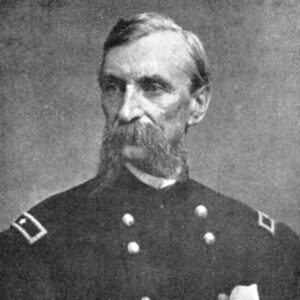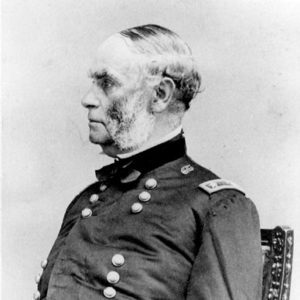calsfoundation@cals.org
Skirmish at Batesville (May 3, 1862)
| Location: | Independence County |
| Campaign: | Pea Ridge Campaign |
| Date: | May 3, 1862 |
| Principal Commanders: | Brigadier General Samuel R. Curtis, General Alexander Asboth (US); Colonel W. O. Coleman (CS) |
| Forces Engaged: | Thirty-sixth Illinois Volunteer Infantry, Major William D. Bowen’s Missouri Cavalry Battalion (US); Fourth Missouri Cavalry Regiment (CS) |
| Estimated Casualties: | 1 wounded (US); 4–6 killed or wounded (CS) |
| Result: | Union victory |
On March 6–8, 1862, one of the most important Civil War battles west of the Mississippi River was fought at Pea Ridge (Benton County) in northwest Arkansas. The Army of the Southwest under Brigadier General Samuel R. Curtis defeated the Confederate army of Major General Earl Van Dorn, with the result that Missouri remained in the Union and the path into Arkansas was open to the Union army, hampered only by Confederate units who were trying to block the paths south and east of Pea Ridge.
Gen. Curtis was following his orders to take his large army of more than 20,000 and seize Little Rock (Pulaski County), thus securing Arkansas for the Union. His Army of the Southwest contained regiments from Indiana, Illinois, Wisconsin, Missouri, Kansas, Iowa, and Nebraska. They crossed the southern part of Missouri to West Plains, where they learned that Colonel W. O. Coleman, commander of a Confederate force, was at Batesville (Independence County) with a force of 400 Rebels. Curtis decided to capture the entire unit before they could be reinforced. On May 1, leaving his army, his staff, and his headquarters at Salem (Fulton County) with instructions to follow as rapidly as possible, Curtis accompanied General Alexander Asboth on a rapid march to the south with an infantry brigade, several cavalry detachments, and an artillery battery.
On May 2, they advanced to Poke (or Polk) Bayou, about sixteen miles above Batesville, and rested until evening. The Union force entered Batesville about five o’clock the next morning and captured “a half dozen Confederates, who were not aware of our presence until summoned to surrender. A large amount of sugar, rice and other stores fell into our hands.”
The two ferries across the White River were seized. Col. Coleman was encamped in the woods on the south side of the river, out of range of the Union shells. The Union troops occupied Batesville but were not able to cross the river to attack the enemy, as there were but two or three small flatboats available.
Coleman soon made his appearance with more than 100 men, who posted themselves behind trees, logs, and an old store house. They opened a rapid fire from the south side of the river, but at too long a range to be effective. Curtis ordered that a howitzer be brought up, and the battery fired a few accurate shells across the river: “They were observed to carry away four of their number, either killed or wounded, while no one was injured on our side.”
Among the killed was Lieutenant Colonel Douglas McBride, son of General James H. McBride. His body was left unburied by the Confederates, who hastily retreated from the vicinity. Several days afterward, he was buried by a detail of Union soldiers.
In this exchange of fire, which can barely be called a skirmish, much less a battle, the citizens of Batesville witnessed the first violence of the war at home. As reported by Mrs. Burton Arnold, Sr., a descendant who had heard eyewitness accounts of the affair: “More people came out of town and went to the river to watch the battle than there were soldiers who took part in it.” The massive Army of the Southwest bivouacked in Independence County for almost two months before moving southeast to Helena (Phillips County).
For additional information:
Bennett, L. G., and Wm. M. Haigh. History of the Thirty-Sixth Illinois Volunteers. Aurora, IL: Knickerbocker and Hodder, 1876. Online at http://www.archive.org/stream/historyofthirtys00benn/historyofthirtys00benn_djvu.txt (accessed January 24, 2022).
James, Nola A. “The Civil War in Independence County, Arkansas.” Independence County Chronicle 26.1–4 (1985): 1–88.
George E. Lankford
Batesville, Arkansas
 Civil War Timeline
Civil War Timeline Military
Military ACWSC Logo
ACWSC Logo  Alexander Asboth
Alexander Asboth  Samuel Curtis
Samuel Curtis 




Comments
No comments on this entry yet.